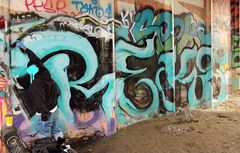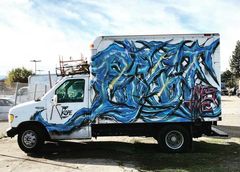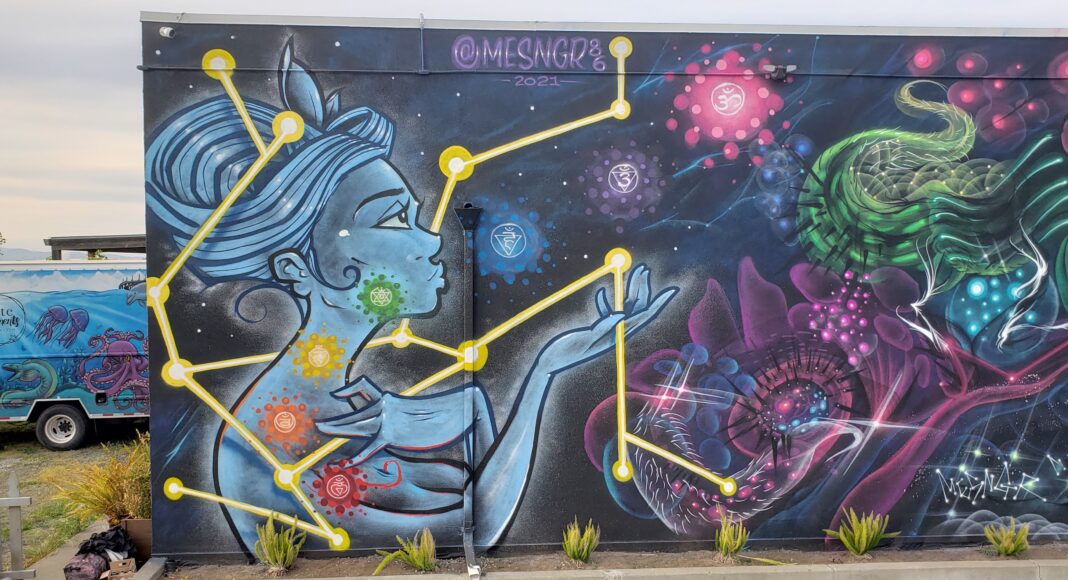San Jose’s streets are rich in art. A walk through downtown or Japantown rewards pedestrians with stories-high murals and colorful utility boxes. Online, San Jose’s Public Art Program boasts 250 public artworks across 130 locations.
On the other hand, the city’s website offers contact information for agencies you can call for graffiti removal along with instructions on how to volunteer to clean up graffiti. Enlistees receive a kit with safety goggles, solvent and other tools.
Back in 2000, Shepard Fairey—street artist and creator of the “Andre the Giant Has a Posse,” “Obey” and the Obama “Hope” designs—had a solo exhibition in San Jose. While Fairey was in town, his posters went up around the city, affixed to walls with wheat paste.
They were taken down as soon as the next day. At that time, the anti-graffiti taskforce was well funded in San Jose.
So what is street art and what is graffiti?
One could see them side by side a couple weeks ago in downtown San Jose: a mural covered by looping, chest-high letters and smaller tags obfuscating the figures in the mural. Both artist and tagger are driven by the need to make a mark, to be seen. But what makes one worthy of preservation and the other of erasure?
WRITE PLACE
Inside the Writers Bench box truck, rope lights pulse through the colors of the rainbow. I look around and say, “I feel like I’m in—”
Dre’s smile cracks like a can as I struggle to describe the interior. “A high school buddy’s room?” he jokes, gesturing to the video arcade game, the glass case of fat markers, the rack of chips.
Buni, who works alongside Dre at Writers Bench, laughs easily while Rue, their tiny dog, turns in her red sweater and settles with a huff. Writers Bench indeed has the comfort of a high school buddy’s room, especially if that buddy has dollar bills taped to their ceiling and spray paint cans displayed on the wall.
A mobile art supply truck, Writers Bench finds its home in a lot at 1225 E Santa Clara St. Recounting how the Writers Bench came to park there, Dre says, “I like working with the public. COVID really opened up networking. Like, for instance, with the owner of this lot. You know he needs help attracting attention and, well hey, I need space for artists. They go hand-in-hand and it prevents graffiti—vandalism-type graffiti.”
The parking lot’s walls are rich with fully realized pieces—graffiti-style lettering, characters and colorful backgrounds form a tapestry on the gray cinder block. To use Dre’s distinction, this is not “vandalism-type graffiti.” Artists came with express permission to paint these works during the inaugural Writers Bench Writers Ball.
The Writers Ball—which Writers Bench hopes to host every other month—is a gathering of artists, musicians and vendors. Dre says that the event drew all types.
“You’ve got the tough-looking artists, you’ve got the skateboarders, you’ve got the nerds, you’ve got people who are into street art. There were business owners, teachers and musicians.”
Beyond the Writers Ball, Writers Bench has solicited donations for folks in need by throwing an art show and held a brief partnership with Kiwibot, the goods distribution robot, to deliver supplies to the unhoused. They also threw a participatory art making event in Saint James Park.
Dre maintains that one reason graffiti writers write is simply to express themselves. Dre wants to offer artists opportunities to further their practice and uses the carrot of an available wall on the lot to encourage artists to keep sketching.
“Get better. Get elevated. Do something with it,” he encourages young graffiti writers.
Writers Bench also supports artists by selling their merchandise in the box truck and brokering commissions. Dre and Buni describe this process as follows: business owners walk by, see the walls and ask how they can get similar work done. The Writers Bench then connects the artist and business according to their budgets and rates.
“We are creating jobs, man,” Dre says. A bonus to working with the Writers Bench is that artists who are respected within the graffiti community are less likely to have their work tagged over: the murals outside the Writers Bench remain unmarked.
SOCIAL NETWORK
On a blustery afternoon in Bestor Art Park, Chris Faria is hunched against the wind, blinking past his dark eyelashes.
Faria is the photographer behind the Instagram page City of Vandals, where he documents the graffiti of San Jose and beyond with the help of co-collaborator and rapper DaChief. In addition to his photography, Faria interviews artists and musicians on a YouTube-based podcast.
One thing is clear to Faria: Graffiti is not about gangs, like many people might think. All sorts of people do graffiti.
“Every person is different, so graffiti—and why they do it—will be different,” Faria tells me. “They have regular jobs and then they go out on some Batman shit and go do it at night.”
“You don’t even know what age they are. That’s the cool thing about it too. Some of these kids are freaking 16 years old and some of these people are 45 and they want to feel that rush again or something.”
Those who write graffiti often do it to get respect from other experienced and original members of the graffiti community. Getting one’s name up—and having good, original style—is of utmost importance in gaining this respect.
“You can have money or you can be flat broke but, if your name is up, that is it right there. It doesn’t matter if you live in a tent or a car, your name is up and it gets noticed.”
People also do graffiti to honor those who have died. “They are also doing it for their friends. The ones that they lost. The ones that passed away,” Faria says. And people can do graffiti out of malcontent, a desire for notoriety, or for reasons even they don’t fully comprehend.
“Sometimes they don’t understand why they do it—I’ve heard that too,” Faria says.
There are also graffiti artists with a more activist bent—Faria cites the group In Decline, who most famously hung businessman mannequins off of billboards with messages like “Dying for work” and “Hope you’re happy Wall St.”
Faria is clear that he himself is not a graffiti writer and he makes no claims to speak from within the culture—his role is one of documentation, amplification, and support for graffiti writers and artists. Some graffiti writers are opposed to his documentation; others are grateful, especially when Faria has captured a piece that has since been erased or was written by someone who has since passed away.
Moving beyond documentation, Faria and collaborators hosted an art show at the MILQ Tea Lounge. Though some in the community view selling work as denying graffiti’s true nature, Faria thinks otherwise.
“Let them sell their stuff. They are trying to do good by themselves,” he says. He wants to host more shows where folks can sell their work and get their first murals up. The next art show is April 9 at Plata Arroyo Skatepark.
“If we can get money in their pockets, that’s sick.”
GALLERY WALLS
The room is full of smoke and a goblin crouches in the corner. Lured by a poster of works on view in the gallery, I stumble into the dark interior of Anno Domini.
Inside, is Cherri Lakey, co-owner of the gallery—which mounted the 2000 show by Shepard Fairey. We’re looking at a mural by Céline Lyaudet, painted specifically for the French painter’s show here. After Lyaudet’s exhibition closes, it will be painted over to make way for the next artist’s work. Lyaudet’s mural is fraught, energetic, covered in handprints. “She put it up in a day. It was incredible to watch,” Lakey says.
I wonder if this ephemerality has anything to do with the gallery’s roots, which Lakey explains originated by featuring street artists. Lakey and her partner, Brian Eder, “wanted to talk about and be a part of what they [the street artists] were doing.”
Another renowned street artist featured by the gallery is David Choe, creator of FX’s The Choe Show. Choe, Lakey explained, would paint giant whales on the sides of buildings by riding in the back of a truck, spray paint can in hand.
“He was trying to keep property values down,” Lakey says. His work was purposeful and represented the artistic community’s response to gentrification.
The distinction between street art and graffiti as malleable, Lakey says, “Street art comes out of graffiti culture.”
One clear difference is that graffiti is always illegal, while street art can be legal. Lakey hazards that a further distinction might have to do with intentionality—street art attempts to impart some kind of message while graffiti doesn’t necessarily try to do that. But then she rescinds this distinction, saying, “I don’t even know if I am right. Because I don’t know their intention.”
LAYERS ON LAYERS
Krisitina Micotti has been an illustrator for ten years. Currently one of the artists in residence at Empire Seven Studios, she recently had the opportunity to paint a mural along the Guadalupe River Parkway in San Jose. The animals in her piece are ones native to this area, with some flair—a salmon stands in tennis shoes; a Steller’s jay sports headphones.
Empire Seven Studios and Micotti were prepared for what they understood to be the eventuality of graffiti by applying a clear, protective coat on top of the mural, but even still, it stung Micotti to see, one morning, that it had been gone over with graffiti.
“It is like, don’t you know how much work went into that? It is a huge bummer,” Micotti says. “I feel like they [graffiti and street art] should go hand-in-hand, but it gets tricky. It is my baby. Don’t graffiti over her. Maybe if I had murals all over town, I’d be like, whatever. But for this one, it is special to me.”
Micotti is quick to understand, as upset as she might be, that she doesn’t have ownership of that wall—for one, there was graffiti there before, for two, the wall is owned by the city, and for three, there are people living by the river.
“We don’t spend time down there. I don’t know who is doing the graffiti, but it is like we are coming onto people’s turf. It is also a public space.”
Micotti also recognizes graffiti as a valid art form and enjoys seeing familiar names and images pop up around the city. She describes this as a “Where’s Waldo-type experience.”
Indeed, if you look around town with an eye for graffiti, you will start to see familiar names. Camel and Baby are two which come to mind for their placement on particularly death-defying promotories. Micotti cites Strano as one which catches her attention.
Strano’s happy-and-unhappy cube heads stamp many of the over- and underpasses along the South Bay’s highways, where they remind people—or at least me—of the duality of human nature. Sometimes smiling, sometimes not. Or, what makes one person smile can make another frown.
Empire Seven Studios now has its home in the mixed-use apartment building Exhibit Japantown SJC, where single-occupancy units start at $2,500 a month. The apartment complex, which has yet to open, lists an outdoor street art park and indoor murals as among its community amenities. Street art seems to gain a kind of legibility when it is also salable, but Strano’s cube head and Micotti’s remarks remind us: which side are we not seeing?
IN THE AGORA
At Emma Prusch Farm Park, Mesngr stands in the shade of a freestanding, multi-paneled wall. He has his shoes kicked off. The lawn is cool and there is sage and corn in the air.
“Street artists or muralists might not be in tune with a neighborhood or an area whereas someone with a graffiti background or with connections with that area—they’re gonna be more tapped in and know who to tap on the shoulder,” Mesngr tells me.
It is nearing the end of the day at the Mexica New Year Ceremony, where Together We Create—a community art collective—is hosting 13 artists, a few of whom still kneel at the bases of the panels, adding finishing touches in aerosol or acrylic.
“You don’t have to know who tagged up the whole wall, but you can know someone who does know and have them get at this person and say, either they can help or ‘we’re gonna do something dope here,’” Mesngr continues. This kind of communication, between those who live and do graffiti in a neighborhood and those wishing to install artworks in the neighborhood, might make for less graffiti on murals.
When he is not painting signs for businesses like Ike’s Love & Sandwiches or teaching art to continuation school students, Mesngr runs Together We Create with his three collaborators, Wisper, Elba Raquel Romo and Roberto Romo. The group has roots in a graffiti crew from the ’80s called TWC. Currently, Together We Create runs their live art shows at events like the Mexica New Year Ceremony. Their next event is at Viva Calle SJ on May 1.
Mesngr laughs a little when asked if he would call himself a graffiti artist or a street artist.
“I would describe myself as a working artist,” he says.
Mesngr came up writing graffiti and attributes his fascination to a mother who painted and a father who did calligraphy on the side. Penmanship fascinated him. Even something as simple as a tag, which many may disregard as scrawl. “Those people are home practicing in their notebooks,” Mesngr notes.
For Mesngr, artistic expression is paramount. He encourages his students to maintain a creative outlook in their lives and future vocations, even if they don’t want to do art professionally.
True to his working artist identity, midway through the interview, Mesngr springs up, still in socks, and pads through the grass to help someone with his merch. While he is gone, I admire the work of artist King 157 who is lettering “Aqua es Vida” on his panel, deftly handling the letter’s edging and working, mysteriously, from right to left. At another panel, a woman asks the artist how long he has been painting and snaps a picture.
Live art in a public space is crucial to Together We Create. The live aspect is especially important.
“Why? Because people love it,” Mesngr says.
Mesngr adds that with so many different styles and mediums on display at a Together We Create event, viewers have many chances to connect with a piece. “They can say, ‘that one, that’s me,’” he says. Artists, in turn, get an opportunity to sell their work, often after someone asks them straight out if it is for sale. Additionally, Together We Create gives artists, especially developing artists, a chance to learn techniques by watching each other at work.
There, in the late afternoon shade, among the walls of art and their attendant artists, I come to some kind of realization about the integral nature—recognized by San Jose artists, gallery owners and business owners alike—of graffiti. That, while graffiti often gets bad press and can inconvenience, harm, or cost people time and money, it also relates intimately to the building of communities, the engendering of economies. Everyone with whom I spoke on the issue does incredible work to uplift and support the arts and people’s livelihoods.
Before leaving, I ask Mesngr what his own piece means. He weighs his words.
“I sometimes wish I was the kind of artist who knew exactly what my pieces are about,” he says. Instead, he often asks viewers what they think. He describes making the canvas—a friend held the pose and he took her photo. As Mesngr began working, another person reminded him of one of his pieces in which a dog casts a shadow puppet, so he moved the female figure down, put a raven above her and wrapped her hands as if to make a bird shadow. A real community effort.
If I were to offer another interpretation, per Mesngr’s invitation, it would go thus: graffiti is not an ill to erase, but a shadow to embrace and better understand.
Follow the Artists
Barron Storey: “The Illustrious Barron Storey” and “Death, God, Love” by Mike Egan
AD Gallery located at 366 S. 1st St, San Jose.
Thursdays & *Fridays Noon–7pm
Saturdays Noon–5pm
*First Fridays 5–9pm
Follow @barronstorey for details
City of Vandals: Art Show on April 9 Noon–6pm at Plata Arroyo Skatepark, N. King Road.
Follow @cityofvandals for details.
Writers Bench: Follow @writersbench_ for real-time truck location and upcoming Writers Ball.
Kristina Micotti: Follow @kristinamicotti and purchase artworks at kristinamicotti.com.
Together We Create: Live Art Show on May 1 at Viva Calle SJ.
Follow @twc408 for details.
San Jose Walls—April 30–May 9


Rekt – City of Vandals 

Rekt-City of Vandals 

The Writer’s Bench Truck 

Nite Owl- Writer’s Bench 

Mesngr Art



